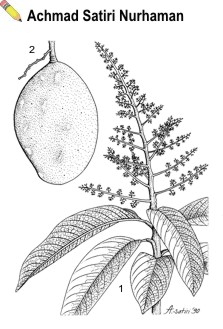Record Number
4420
PROSEA Handbook Number
5(2): Timber trees; Minor commercial timbers
Taxon
Mangifera odorata Griffith
This article should be read together with the article on the genus: Mangifera (timber aspects) in the Handbook volume indicated above in this database.
This article should be read together with the article on the genus: Mangifera (timber aspects) in the Handbook volume indicated above in this database.
Protologue
Not. pl. asiat. 4: 417 (1854).
Synonyms
Mangifera foetida Lour. var. bombom, var. kawini and var. mollis Blume (1850), Mangifera foetida Lour. var. odorata (Griffith) Pierre (1897).
Vernacular Names
Kuwini (En). Kuweni, manguier odorant (Fr). Indonesia: bembem, kaweni (Sundanese, Java), k(u)weni (Malay, Sumatra, Kalimantan; Javanese, Java). Malaysia: kuini (Malay, Sabah, Sarawak), huani or wani (Sabah). Philippines: (h)uani (Cebu, Bisaya), juani (Jolo). Thailand: kinning (Narathiwat), mamuang-chingrit, mamuang-pa (central).
Distribution
The origin of Mangifera odorata remains unknown; it has not been found in the wild. It is cultivated throughout western Malesia.
Uses
The wood is used locally as machang, but is reportedly of poor quality. The fruits are eaten fresh, but must be peeled thickly because of the irritating sap; young fruits are used for making chutney and pickles. A flour made from the seed kernels is used in the preparation of delicacies. The bark and leaves are used in traditional medicine.
Observations
A medium-sized tree up to 30 m tall, with straight cylindrical bole up to 80 cm in diameter, bark surface initially smooth, later fissured, grey; leaves oblong-lanceolate to elliptical-lanceolate, 12—35(—40) cm 4—10(—13) cm; inflorescence pseudo-terminal, pyramidal, rather densely flowered; flowers 5-merous, petals 4—6 mm long, initially white, at the base with a yellow spot (consisting of 3—5 ridges confluent at base) circled by red, gradually discolouring to reddish, disk fleshy, stipe-like, one stamen fertile (rarely two), staminodes smaller and unequal, filaments connate at base; fruit obliquely ovoid, ellipsoid or oblong, up to 13 cm long, yellowish-green with numerous yellow or brown dots when ripe, fragrant. Mangifera odorata is cultivated in areas with a fairly heavy rainfall that is equally distributed throughout the year.
Image
 | Mangifera odorata Griffith – 1, flowering twig; 2, fruit. |
Selected Sources
[104]Corner, E.J.H., 1988. Wayside trees of Malaya. 3rd edition. 2 volumes. The Malayan Nature Society, Kuala Lumpur. 774 pp.
[162]Flora Malesiana (various editors), 1950–. Kluwer Academic Publishers, Dordrecht, Boston, London.
[328]Kostermans, A.J.G.H. & Bompard, J.-M., 1993. The mangoes. Their botany, nomenclature, horticulture and utilization. International Board for Plant Genetic Resources and Linnean Society of London. Academic Press, London. 233 pp.
[463]Ng, F.S.P., 1991. Manual of forest fruits, seeds and seedlings. Vol. 1. Malayan Forest Record No 34. Forest Research Institute Malaysia, Kepong. 400 pp.
[465]Ng, F.S.P. & Mat Asri Ngah Sanah, 1991. Germination and seedling records. Research Pamphlet No 108. Forest Research Institute Malaysia, Kepong. 191 pp.
[673]Verheij, E.W.M. & Coronel, R.E. (Editors), 1991. Plant resources of South-East Asia No 2. Edible fruits and nuts. Pudoc, Wageningen. 446 pp.
[705]Whitmore, T.C. & Ng, F.S.P. (Editors), 1972–1989. Tree flora of Malaya. A manual for foresters. 2nd edition. 4 volumes. Malayan Forest Records No 26. Longman Malaysia SDN. Berhad, Kuala Lumpur & Petaling Jaya.
[162]Flora Malesiana (various editors), 1950–. Kluwer Academic Publishers, Dordrecht, Boston, London.
[328]Kostermans, A.J.G.H. & Bompard, J.-M., 1993. The mangoes. Their botany, nomenclature, horticulture and utilization. International Board for Plant Genetic Resources and Linnean Society of London. Academic Press, London. 233 pp.
[463]Ng, F.S.P., 1991. Manual of forest fruits, seeds and seedlings. Vol. 1. Malayan Forest Record No 34. Forest Research Institute Malaysia, Kepong. 400 pp.
[465]Ng, F.S.P. & Mat Asri Ngah Sanah, 1991. Germination and seedling records. Research Pamphlet No 108. Forest Research Institute Malaysia, Kepong. 191 pp.
[673]Verheij, E.W.M. & Coronel, R.E. (Editors), 1991. Plant resources of South-East Asia No 2. Edible fruits and nuts. Pudoc, Wageningen. 446 pp.
[705]Whitmore, T.C. & Ng, F.S.P. (Editors), 1972–1989. Tree flora of Malaya. A manual for foresters. 2nd edition. 4 volumes. Malayan Forest Records No 26. Longman Malaysia SDN. Berhad, Kuala Lumpur & Petaling Jaya.
Author(s)
R.H.M.J. Lemmens
Correct Citation of this Article
Lemmens, R.H.M.J., 1995. Mangifera odorata Griffith. In: Lemmens, R.H.M.J., Soerianegara, I. and Wong, W.C. (Editors): Plant Resources of South-East Asia No 5(2): Timber trees; Minor commercial timbers. PROSEA Foundation, Bogor, Indonesia. Database record: prota4u.org/prosea

All texts are licensed under a Creative Commons Attribution-Noncommercial-Share Alike 3.0 Netherlands License
This license does not include the illustrations (Maps,drawings,pictures); these remain all under copyright.